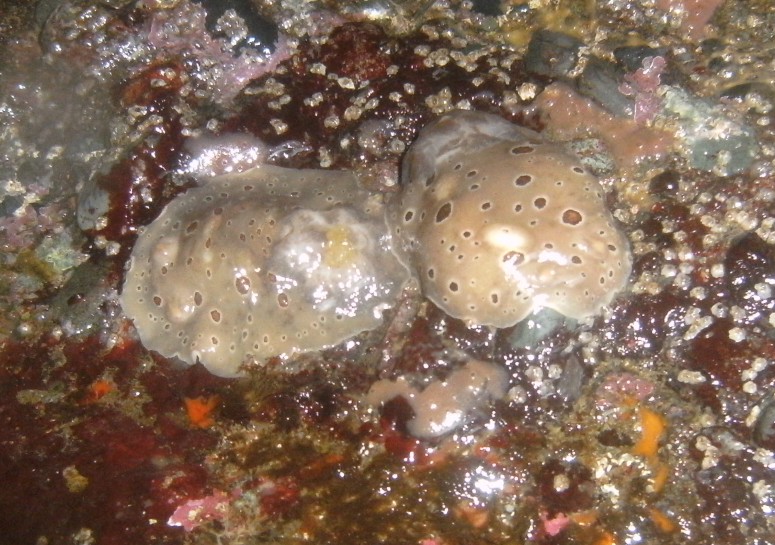Diaulula odonoghuei Steinberg 1963Common name(s): Spotted dorid |
|
| Synonyms: part of Diaulula sandiegensis, Doris echinata |  |
|
Class Gastropoda
Family
Discodorididae
|
|
| Two Diaulula odonghuei found at Cape Flattery | |
| (Photo by: Dave Cowles, July 2012 ) | |
Description:
The anus is on the midline of the dorsum, 1/2 to 3/4 of the way from
the anterior end. Gills in a circle around the anus. Though the dorsum
has small papillae (visible only with a microscope), the only
conspicuous dorsal outgrowths are
the rhinophores and the gills. The gills can be completely retracted.
The rhinophores are relatively stout. The dorsum is white, gray, light
or dark brown, or occasionally orange. with large, scattered brown
spots or rings. These spots occur both on the central part of the
dorsum and out to the mantle edges. Number of spots may range from
around 23 to 234 (mean of 78)(Lindsay et al., 2016).
How to Distinguish
from
Similar Species:
This species appears very similar to D. sandiegensis and
until recently was considered to be the same species. The most clear
distinction is that this species has dorsal spots on both the central
portion of the dorsum and out to the mantle edges, while D. sandiegensis
does not have spots or rings near the mantle edges. Also, the spots on D. sandiegensis are
usually (not always) rings, while those on this species are
usually (not always) solid spots. Also, in the Pacific Northwest this
species is usually intertidal while D. sandiegensis is
mainly subtidal here.
Geographical Range:
Japan and Korea through Alaska south to Bodega Bay (northern California).
Depth Range:
Mostly intertical in the Pacific Northwest
Habitat:
Mostly rocky intertidal on the open coast and in bays
Biology/Natural History: As individuals of this species grow, they accumulate more dorsal spots, and the dorsal spots also grow larger (Lindsay et al., 2016). Individuals of this species appear to feed primarily on purple Haliclona sponges. Molecular analysis indicates that there is little gene exchange between the populations on the west coast of North America and those in Asia.
Until recently this species was considered to be a variant of Diaulula sandiegensis.
Lindsay et al., 2016 established molecularly and confirmed by
morphology and breeding choices that the species is separate from D. sandiegensis.
| Return to: | |||
| Main Page | Alphabetic Index | Systematic Index | Glossary |
References:
Dichotomous Keys:
Kozloff keys this species in combination with D. sandiegensis)
General References:
Scientific Articles:
Lindsay, Tabitha, Julie Kelly, Anton Chichvarkhin, Sean Craig,
Hiroshi Kajihara, Joshua Mackie, and Angel Valdes, 2016. Changing
spots: pseudocryptic speciation in the North Pacific dorid nudibranch Diaulula sandiegensis (Cooper, 1863) (Gastropoda: Heterobranchia). Journal of Molluscan Studies 82:4 pp 564-574. doi: 10.1093/mollus/eyw026
Web sites:
General Notes and
Observations: Locations,
abundances, unusual behaviors:
Authors and Editors
of
Page:
Dave Cowles (2019): Created original page
CSS coding for page developed by Jonathan Cowles
Salish Sea Invertebrates web site provided courtesy of Walla Walla University